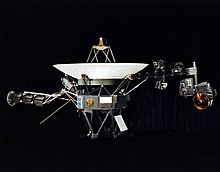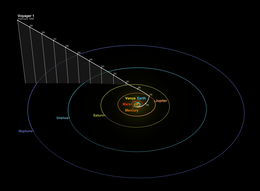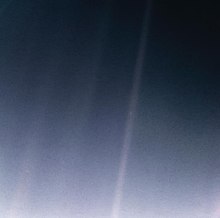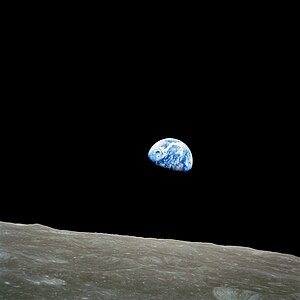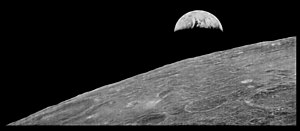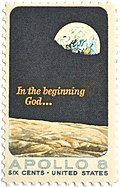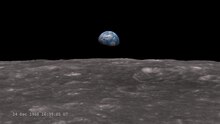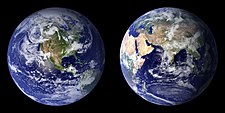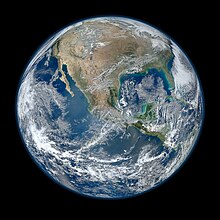From Wikipedia, the free encyclopedia
The Blue Marble by the crew of
Apollo 17 (1972)
The Blue Marble is an image of Earth taken on December 7, 1972, from a distance of about 29,000 kilometers (18,000 miles) from the planet's surface. It was taken by the crew of the Apollo 17 spacecraft on its way to the Moon, and is one of the most reproduced images in history.
It mainly shows the Earth from the Mediterranean Sea to
Antarctica. This was the first time the Apollo trajectory made it
possible to photograph the south polar ice cap, despite the Southern Hemisphere being heavily covered in clouds. In addition to the Arabian Peninsula and Madagascar, almost the entire coastline of Africa is clearly visible. The Asian mainland is on the horizon.
NASA
has also applied the name to a 2012 series of images which cover the
entire globe at relatively high resolution. These were created by
looking through satellite pictures taken over time in order to find as
many cloudless photographs as possible to use in the final images.
The photograph
The photograph, taken on December 7, 1972, at 05:39 a.m. EST (10:39 UTC), is one of the most widely distributed photographic images in existence.
The image is one of the few to show an almost fully illuminated Earth
as the astronauts had the Sun behind them when they took the image. To
the astronauts, the slightly gibbous Earth had the appearance and size of a glass marble,
hence the name. It has been mostly shown with Antarctica at the bottom,
although the actual view the astronauts had was with Antarctica on top.
History
AS17-148-22727, from which The Blue Marble was cropped. The photograph's original orientation had south pointed up.
The photograph was taken about 5 hours 6 minutes after launch of the Apollo 17 mission, and about 1 hour 54 minutes after the spacecraft left its parking orbit around Earth, to begin its trajectory to the Moon.
The time of Apollo 17's launch, 12:33 a.m. EST, meant that Africa was
in daylight during the early hours of the spacecraft's flight. With the
December solstice approaching, Antarctica was also illuminated.
The 1972 Tamil Nadu cyclone can be seen in the bottom left of the image. This storm had brought flooding and high winds to the Indian state of Tamil Nadu on December 5, two days before the photograph was taken.
The photograph's official NASA designation is AS17-148-22727. NASA photograph AS17-148-22726, taken just before and nearly identical to 22727, is also used as a full-Earth image. The widely published versions are cropped and chromatically adjusted from the original photographs.
The photographer used a 70-millimeter Hasselblad camera with an 80-millimeter Zeiss lens. NASA credits the image to the entire Apollo 17 crew—Gene Cernan, Ronald Evans and Harrison Schmitt—all
of whom took photographs during the mission with the on-board
Hasselblad, although evidence examined after the mission suggests that
Schmitt was the photographer.
All Apollo flights were heavily scheduled down to the minute. At
the time this photo was taken, none of the astronauts was scheduled to
do so. Thus this photo was taken quickly in a stolen moment. The
astronaut who took the picture was weightless, and the continents were
hard to see, and he took the photo quickly, which explains the photo’s
orientation, compared to the north up orientation of most maps.
Apollo 17 was the last crewed lunar mission. No human since has been far enough from Earth to photograph a whole-Earth image such as The Blue Marble, but whole-Earth images have been taken by many uncrewed spacecraft missions.
The Blue Marble was not the first clear image taken of an illuminated face of Earth, since similar shots from the ATS-3 satellite had already been made as early as 1967. The Apollo 17 image, however, released during a surge in environmental activism
during the 1970s, became a symbol of the environmental movement, as a
depiction of Earth's frailty, vulnerability, and isolation amid the vast
expanse of space. NASA archivist Mike Gentry has speculated that The Blue Marble is among the most widely distributed images in history.
Subsequent Blue Marble images
Subsequent similar images of Earth (including composites at much higher resolution) have also been termed Blue Marble images, and the phrase "blue marble" (as well as the picture itself) is frequently used, as in the Earth flag
by environmental activist organizations or companies attempting to
promote an environmentally conscious image. There has also been a
children's television program called Big Blue Marble. Poet-diplomat Abhay Kumar penned an Earth anthem
inspired by the Blue Marble which contains "all the peoples and the
nations of the world, one for all, all for one, united we unfurl the
blue marble flag".
Imaging series 2001–2004
Blue Marble composite images generated by NASA in 2001 and 2002.
In 2002, NASA released an extensive set of satellite-captured
imagery, including prepared images suitable for direct human viewing, as
well as complete sets suitable for use in preparing further works. At the time, 1 km/pixel was the most detailed imagery available for free, and permitted for reuse
without a need for extensive preparatory work to eliminate cloud cover
and conceal missing data, or to parse specialized data formats. The data
also included a similarly manually assembled cloud-cover and
night-lights image sets, at lower resolutions.
A subsequent release was made in 2005, named Blue Marble Next Generation. This series of photo mosaics was produced with the aid of automated image-sifting upon images from NASA's Earth Observatory,
which enabled the inclusion of a complete, cloud-free globe for each
month from January to December 2004, at even higher resolution
(500 m/pixel).
The original release of a single-image set covering the entire globe
could not reflect the extent of seasonal snow-and-vegetative cover
across both hemispheres, but this newer release closely modeled the
changes of the seasons.
A number of interactive viewers for these data have also been released, among them a music visualization for the PlayStation 3 that is based on the texture data.
Blue Marble 2012
Blue Marble 2012 – a composite satellite image
On January 25, 2012, NASA released a composite image of the Western Hemisphere of Earth titled Blue Marble 2012. The picture logged over 3.1 million views on the Flickr image hosting website within the first week of release. On February 2, 2012, NASA released a companion to this new Blue Marble, showing a composite image of the Eastern Hemisphere from data obtained on January 23, 2012.
The picture is composed of data obtained by the Visible/Infrared Imager Radiometer Suite (VIIRS) instrument on board the Suomi NPP satellite on January 4, 2012. The data was obtained from six orbits of the Earth by the Suomi NPP over an eight-hour period. The image was created using a near-sided perspective projection
with the viewing point placed 2100 km above 20° North by 100° West.
This projection results in a very wide-angle presentation such as one
might get with a fish-eye lens, and it does not include the whole
hemisphere.
Black Marble 2012
Black Marble – North and South America at night,
Hurricane Sandy can be seen off the coast of Florida.
On December 5, 2012, NASA released a nighttime view of Earth called Black Marble during an annual meeting of Earth scientists held by the American Geophysical Union in San Francisco. The images display all the human and natural matter that glows and can be detected from space. The data was acquired by the Suomi NPP satellite in April and October 2012 and then mapped over existing Blue Marble imagery of Earth to provide a realistic view of the planet. The Suomi NPP satellite completed 312 orbits and gathered 2.5 terabytes of data to get a clear shot of every parcel of the Earth's land surface. Named for satellite meteorology pioneer Verner Suomi,
the satellite flies over any given point on Earth's surface twice each
day and flies 512 miles (824 km) above the surface in a polar orbit.
The nighttime views were obtained with the new satellite's
"day-night band" of the Visible Infrared Imaging Radiometer Suite
(VIIRS), which detects light in a range of wavelengths from green to
near-infrared, and uses filtering techniques to observe dim signals such
as city lights, gas flares, auroras, wildfires, and reflected
moonlight. Auroras, fires, and other stray light have been removed in
the case of the Black Marble images to emphasize the city lights.
The images have been used to study the spatial distribution of economic
activity, to select sites for astronomical observatories, and to
monitor human activities around protected areas.
DSCOVR
On July 21, 2015, NASA released a new Blue Marble photograph taken by a U.S. Deep Space Climate Observatory (DSCOVR), a solar weather and Earth observation satellite
that was launched in February 2015 and will provide a near-continuous
view of the entire sunlit-side of the Earth. The image was taken on July
6, 2015. The photograph, of the Western Hemisphere, is centered over Central America. The Western United States, Mexico and the Caribbean are visible, but much of South America is hidden beneath cloud cover. Greenland can be seen at the upper edge of the image.
The EPIC science team plans to upload 13 new color images per day
on their website. The color balance has been adjusted to approximate an
image that could be seen with the average human eye. In addition to
images, scientific information will be uploaded as it becomes available
after in-flight calibration is complete. The science information will be
ozone and aerosol amounts, cloud reflectivity, cloud height, and
vegetation information. The EPIC instrument views the Earth from
sunrise in the west to sunset in the east 12 to 13 times per day as the
Earth rotates at 15 degrees of longitude per hour. Clearly visible are
storms forming over the Atlantic and Pacific Oceans, major slowly moving
"cloud rivers", dust aerosol plumes from Africa, the sun's reflection
in the oceans, ship exhaust tracks in the clouds, rivers and lakes, and
the variegated land surface patterns especially in the African deserts.
The spatial resolution of the color images is about 10 km, and the
resolution of the science products will be about 20 km. Once every three
months, lunar images are obtained that are the same as those viewed
from Earth during our full Moon. On occasion, the other side of the Moon
will appear in the Earth images as the Moon crosses in front of the
Earth.


